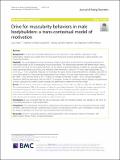Drive for muscularity behaviors in male bodybuiders: a trans-contextual model of motivation

Auteur, co-auteurs
Type de référence
Date
2019Langue de la référence
AnglaisEntité(s) de recherche
Résumé
Background: The drive for muscularity behaviors are very common in male athletes, especially in male bodybuilders. Studies have related drive for muscularity behaviors to body dissatisfaction, eating disorders and muscle dysmorphia. Methods: This study applied the trans-contextual model of motivation to the drive for muscularity behaviors of male bodybuilders at risk of developing muscle dysmorphia. The relationships between self-determination theory constructs and drive for muscularity behaviors, via the theory of planned behavior variables (i.e., attitude, subjective norm, perceived behavioral control, and intention) were examined. A total of 175 Swiss male bodybuilders (Mage = 27.34; SDage = 7.53) completed measures on motivation for sport, theory of planned behavior variables, and drive for muscularity behaviors. They practiced bodybuilding from three to 24 h per week (Mhours per week = 6.59; SDhours per week = 3.45) and had done so for 7.19 years on average (SDnumber of years = 6.91). Using bootstrapped maximum likelihood estimation with the AMOS 7.0 program, a series of confirmatory factor analyses was performed on each subscale and a series of path analyses was performed to determine the final model. Results: The fit indices of the final model were satisfactory: χ2 (11) = 13.81; p = .244; TLI = .98; CFI = .99; RMSEA = .04. The model explained 29% of the variance of drive for muscularity behaviors. The final path analysis supported the motivational sequence, with autonomous motivation for sport showing a positive, significant and indirect association with the drive for muscularity behaviors via perceived behavioral control and intention to gain muscle mass, and controlled motivation for sport showing a positive association with the drive for muscularity behaviors both directly and via attitude and intention to gain muscle mass. Conclusions: It was concluded that the trans-contextual model of motivation applies only partially to the drive for muscularity behaviors in male bodybuilders. Perspective: The motivational mechanisms explaining the development of drive for muscularity behaviors might be better understood through complementary analyses of motivational profiles. Such investigations would guide the design of programs to lower the risks associated with these behaviors.Titre du périodique
Journal of Eating DisordersMaison d’édition
BioMed CentralPays d'édition
Royaume-Unie-ISSN
2050-2974Evaluation par les pairs (peer reviewing)
ouiVolume / tome
7Fascicule
44Pagination
1-11Public(s) cible(s)
Chercheursprofessionels du domaine
Etudiants
URL permanente ORFEE
http://hdl.handle.net/20.500.12162/3840Autre(s) URL(s) permanente(s)
http://doi.org/10.1186/s40337-019-0274-yDocument(s) associé(s) à la référence
Texte intégral :
Fichier
Accès
Commentaire
Version
Taille
- Tout ORFEE
- Détail référence



